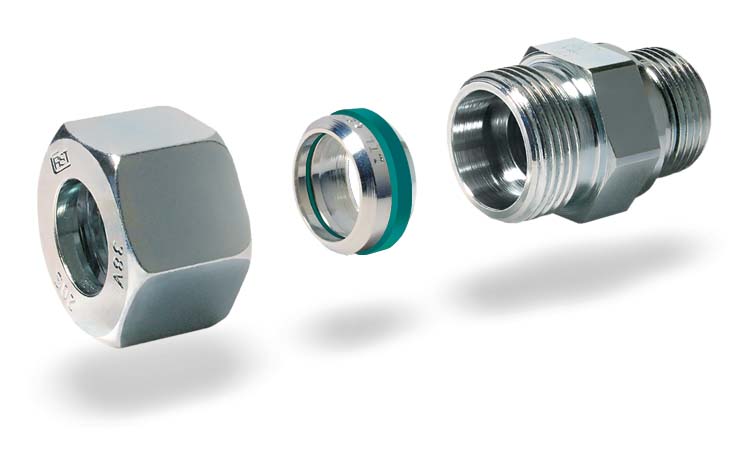
DIN 2353 B4
NEUER SCHNEIDRING MIT SECHS DICHTUNGEN. INTERNATIONALES PATENT NR. 864061 VOM 10.03.1999, ERGÄNZT DEN DERZEIT VERWENDETEN STANDARDRING, ERSETZT DIESEN JEDOCH NICHT.
HERGESTELLT AUS UNLEGIERTEM STAHL UND AUS EDELSTAHL.
 GRUNDPRINZIP
GRUNDPRINZIP
Der „B4“ ist ein neuer Ringtyp mit zwei Schneiden und doppelter Elastomerdichtung. Er wird mit den bekannten Techniken montiert und ist mit allen Typen von Ringen austauschbar, die auf Anschlüssen mit 24° Kegel nach ISO 8434-1/DIN 2353 verwendet werden. Mit dem Ring können schnell demontierbare Verrohrungen realisiert werden, da Schweißen, Gewindeschneiden und Bördelungen vermieden werden. So wird der Aufbau von komplexen öldynamischen Anlagen so einfach wie möglich gemacht. Beim Verschrauben mit der Mutter dringt der Schneidring in den 24° Kegel, schneidet mit seinen zwei Schneiden in das Stahlrohr ein und bewirkt zwei tiefe Einschnitte. Der erste, sichtbar durch den Aufwurf eines Außenrands auf dem Rohrumfang, garantiert Dichtheit und Schutz gegen Abziehen des Rings vom Rohr; der nicht sichtbare zweite Einschnitt hilft, die Kräfte gleichmäßig auf den gesamten Ring zu verteilen. Er verhindert, dass Vibrationen den ersten Einschnitt erreichen und begrenzt die Einschnitttiefe durch einen vordefinierten Wert.
DIN 2353 B4
SNEW SIX-SEALS CUTTING RING.
INTERNATIONAL INDUSTRIAL PATENT Nr. 864061 of the 10/03/99
FLANKS AND DOES NOT REPLACE THE STANDARD RING CURRENTLY IN USE
AVAILABLE IN CARBON AND STAINLESS STEEL
 THEORY OF OPERATION
THEORY OF OPERATION
The “B4” is a highly innovative, deformable, double clinching, double edge ring with double elastomer seal that is assembled according to well-known techniques and is perfectly interchangeable with all types of rings used on 24° cone fittings complying with the ISO 8434-1/DIN 2353 standards.
The ring helps fast assembly of removable tubes, avoids welding, tapping and flaring, thus assuring maximum simplicity of complex oleo-dynamic systems.
During tightening by the nut, the ring deforms according to the bore of the 24° cone of the fitting and bites into the steel tube, producing two deep cuts the first of which is visible due to lifting of an outer edge on the diameter of the tube, allows the water tightness and anti-unthreading of the ring. The second groove (invisible) balances the forces on the whole ring, prevents vibrations to reach the first groove and stops the stapling of the tube at a predetermined value.